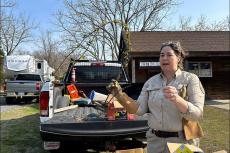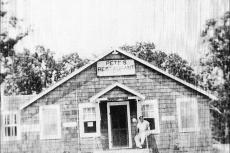After being named one of the 11 Most Endangered Historic Places in the United States earlier this year, the Springs property of the late artists James Brooks and Charlotte Park will now be the beneficiary of a full-on historical architectural assessment by Michael Devonshire of Jan Hird Pokorny Associates, a New York City firm “with a strong focus in historic preservation work,” according to its website.
At its Dec. 15 meeting, the East Hampton Town Board approved a contract for up to $21,000 to Mr. Devonshire to prepare a report summarizing his observations and recommendations for possible repairs and renovation of the former home of the late Abstract Expressionist artists.
In May, the National Trust for Historic Preservation identified the 11-acre site off Neck Path as “not just nationally significant [but] internationally significant,” given the artists’ prominence and their friendship with other prominent artists of the day, including Jackson Pollock and Lee Krasner, who lived nearby in Springs.
The town bought the property — which includes the married artists’ studios, a residence, and a cottage — in 2013 for $1.1 million using community preservation fund money with the intent of demolishing the buildings to create open space.
Pushback from residents intent on preserving the buildings prompted the town to designate the property a town historic landmark in 2014, which, as The Star reported earlier this year, “allowed for C.P.F. money to be spent toward the site’s restoration, but not for its management.”
Then, in 2018, the town board approved $850,000 to restore the site, only to have the town’s property management committee conclude the following year that deterioration of the buildings made for a cost-prohibitive restoration, and recommended that the structures be demolished.
A demolition permit was approved in 2020, at which point a new nonprofit called for the creation of the Brooks-Park Arts and Nature Center, which the nonprofit would manage.
In 2016, the town enlisted the engineer Drew Bennett to assess the condition of the structures. He performed another assessment in February and told the board in August that in the six years between the assessments, the buildings had been badly vandalized, there were holes in the walls, there was mold and mildew everywhere, and an I-beam that supported the sawtooth roof of the Brooks studio had “basically dropped” and that the building was slowly collapsing.
Mr. Bennett told the board that in his view, saving the Brooks studio wasn’t so much about restoration as reconstruction: It would have to be taken apart and reassembled with new materials.
If all the buildings were restored and the Brooks studio was reconstructed, he concluded, the cost would be just shy of $4 million — some of which, he said, might be offset with C.P.F. money.
At that same August meeting, Janet Jennings, a member of the nonprofit pushing for a full restoration and public access to the site and its surrounding woodlands, asked that the town get a second opinion from a firm that specializes in historic building assessments, noting then that a field observation undertaken by Mr. Devonshire “came to a different conclusion than the Bennett report,” determining that the Brooks studio’s deteriorating condition was “reversible.”
Her wish, at is turned out, became the town board’s command.
Irwin Levy, a 33-year resident of Springs and member of the nonprofit, called in to Thursday’s meeting to support the town’s contract with Mr. Devonshire. “The time is now,” he said. “It’s been out there for a while, the heavy lifting is done, the property is owned, now let’s make this be what it can be for future generations.”
The board’s vote to contract with Mr. Devonshire was unanimous. Councilman David Lys said he had “concerns about the project in general,” but that the best way to address his concerns was to approve the expenditure and see “the scope of what Devonshire is proposing.” He looked forward, he said, to putting Mr. Devonshire’s findings and recommendations together with Mr. Bennett’s to chart a path forward.




